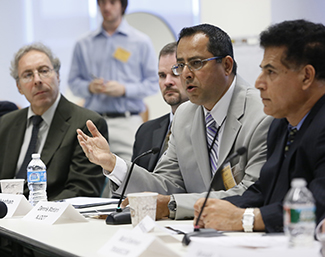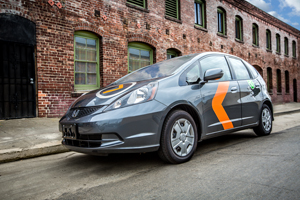NJDOT Veteran Launches National Operations Center of Excellence
Organization's website a hub for transportation systems management and operations community
Dhanish (Dennis) Motiani is the executive director of the National Operations Center of Excellence (NOCoE). Launched in January, the Washington, D.C.-based NOCoE offers peer exchanges, online resources, on-call assistance and training on topics such as integrated corridor management, active traffic management and incident response. Its website (transportationops.org) includes discussion boards, a national events calendar and searchable libraries of studies, publications and multimedia. The NOCoE is a collaboration of the American Association of State Highway and Transportation Officials (AASHTO), the Institute of Transportation Engineers (ITE) and the Intelligent Transportation Society of America (ITS America), with support from the Federal Highway Administration (FHWA).
Prior to joining the NOCoE, Motiani spent 25 years with the New Jersey Department of Transportation (NJDOT), most recently as assistant commissioner for transportation systems management. Motiani is also a former president of ITS-New Jersey, a nonprofit organization dedicated to promoting intelligent transportation systems statewide.
Why is there a need for a National Operations Center of Excellence?
DM: DOTs and the government, whether state or federal, have focused on building highways since Eisenhower’s time. Well, we came to a point where, number one, we didn’t have enough funding, and two, there’s not enough space left to build them anymore, especially in urban areas. So if you can’t build your way out of congestion, what do you do? The solution is a concept called operations. It’s about how do you effectively and efficiently manage your highways and your overall transportation network in a region as a system?

Dennis Motiani discusses integrated corridor management during
a 2012 symposium hosted by the North Jersey Transportation
Planning Authority.We learned that there was no one place to go to for information on the subject. There wasn’t enough information out there, and as new information was collected, it was scattered. There wasn’t a hub for it. A website came out called KTS, the Knowledge Transfer System, which would address those issues. And while KTS was being implemented, users like me when I was in New Jersey and others throughout the country asked for more. Then the name got changed to EKTS, which was the Enhanced Knowledge Transfer System. (The site was developed by AASHTO, ITE and ITS America in collaboration with the Federal Highway Administration.)
While they were designing the EKTS, all of the 50 states said, we want a little more. We want to learn from each other. We want to learn from what Florida has done, what New Jersey has done, what California has done. And how would you do that? You form a community. You form a hub and exchange best prac- tices, over the website and in person. Part of that was developing a technical service program, joined with the EKTS. The collaboration of both efforts would be called the National Operations Center of Excellence.
The Center has been running since January. What services seem to be getting the most interest? How has the buy-in been so far from transportation professionals?
DM: The technical services program in my mind is the meat and potatoes of this program. We have the money to bring in all 50 states for a national summit and say, what’s making you concerned? What’s been keeping you awake at night? We also have money for peer-to-peer exchanges. For example, we can do a peer-to-peer exchange between New York, New Jersey, Connecticut and Pennsylvania on road weather conditions or how you deal during a snowstorm when people start closing bridges. There could be best practices developed there, consistency, and the Center could actually bring them together.
I have two peer-to-peer exchanges being discussed right now. One is with Tennessee. Part of SHRP2 [the Second Strategic Highway Research Program] was a product called Train the Trainer. It was traffic incident management training, and the FHWA wanted to train a million people in 10 years. How do you do that? Well, you train some people and then they go and train others. What Tennessee wants to do is bring in a couple of states and say, “OK, you did Train the Trainer. What did you learn from the sessions? And how can we improve going forward?” I thought that was a great idea. So I’m going to help them find Train the Trainer participants from seven or eight states and bring in some national champions from the FHWA and National Traffic Incident Management Coalition. We’ll sit down and figure out how to make it even better.
We’ve had some traction and seen some interest, but it’s not what I want yet. It’s almost like the dance floor, where everyone wants to see someone dance first. I’m seeing progress. It’s slow, but Rome was not built in a day.
Where do you see the U.S. in terms of its progress in integrating ITS technologies into its operations and infrastructure?
DM: I would like to see a little bit more progress on technology in transportation, but I also understand why we’re slow compared to some other countries. There are liability issues, there are issues with policies. If we do things in haste, we do have litigation in society, and for good reason. We want to prepare everybody.
If you lump in connected vehicles with ITS, then I think we’ve made huge strides over the last few years. It bothers me to see traffic signals still not being synchronized.
There’s a whole lot more that can be done. It requires funding, it requires desire, it requires expertise and knowledge, and I think that is all lacking to some degree. At the Center, we have some of it—the training part, and bringing the information and the knowledge, although not the funding part.
Finish the following sentences with a technology-related answer. In 5 years, ____ will be a common part of travel in America. In 10 years, ____ will be a common part of travel in America. In 25 years, ____ will be a common part of travel in America.
DM: In five years, I see more and more private industries getting into transportation. The Ubers of the world are changing the way we travel. I moved to D.C. and I do not own a vehicle now. I take mass transit, I have Uber, I have a subscription to ZipCar, a subscription to Car2Go. There are different ways of getting from point A to point B. The Millenials are changing how we travel. I also see vehicles with more and more technology. We already see the blind spot detection systems. Adaptive cruise control is going to become almost standard. Overall, we’ll see much smarter vehicles.

ZipCar
Motiani believes the emergence of private industries like
ZipCar and ride-hailing apps will change how Americans travel.Ten years, if you do not have any automation in your car, I think it will be treated almost as an antique. By 10 years, you will see a huge, huge impact on the safety side of transportation. We should definitely see reductions in certain kinds of accidents. If we don’t see that, then something went wrong somewhere. The way things are progressing right now, there is so much research and so much interest. Google does not get involved and let things string along for too long, so I think it’s forced the Mercedes, Volvos and Hondas of the world, and GM and Ford, to do something in the near future.
Twenty-five years, I certainly see a vehicle coming to your door. If I’m a senior citizen and I should not be driving at that point perhaps, this vehicle is just going to come in, I can tell it where I want to go and it will take you to the place. It could be a vehicle carrying single people or a pool car that drops some people here, some people there. With all of that automation, we are ready now to give up a little bit of freedom to get some more freedom back. Giving up the car will be a little bit difficult because we want to drive something, so we’ll still continue the way that we have been. But there will be some people who will say, "That’s OK, I want to take this new means of transportation."
Before launching NOCoE, you spent 25 years at the NJDOT, as well as a term as president of
ITS New Jersey. How did those experiences prepare you for this latest role?
DM: The government job helped me in understanding all aspects of transportation systems management and operations (TSM&O), from work zones to incident management, to traffic management, to traffic signals. When I get calls and talk to people, it’s not like a sales person or consultant selling something. I’ve been there, I’ve done it, and I think that gives me credibility.
ITS-New Jersey gave me a different type of experience, which I think was equally important, and that was to learn about nonprofit associations, and to think regionally, to think outside the DOT box. That’s what this job requires here now. I actually talk to a board comprised of three different associations—AASHTO, ITE and ITS America. How do they work and how do I deal with them? I also learned how you start something from almost scratch, because ITS-New Jersey was dormant [when I became its president]. It’s helping me start something new.
What lessons can New Jersey’s ITS experience offer to the rest of the country?
DM: A lot of states have pretty extensive ITS experience. New Jersey certainly has its own share. Have some learned from New Jersey? Absolutely. We shared what we did with the Super Bowl in 2014. We wrote a TSM&O plan which one or two other states are looking towards adopting. We put some adaptive signal systems out there, which many other states have done, but ours were a little bit more complex. There are lessons to be learned from the Pulaski Skyway reconstruction project—the use of technology to measure the traffic impact is something that many states can learn from.
But at the same time, New Jersey can learn from a lot of other progressive states like Florida, California, Washington, Michigan and Virginia, just to name a few. Every state out there is trying to do something, and that’s exactly why the Center is here. Everyone is doing something different. Some of it is similar, but one state has more headway here, one state has more headway there. Let us all bring it and share it on the Center site.
Karl Vilacoba is the managing editor of InTransition.